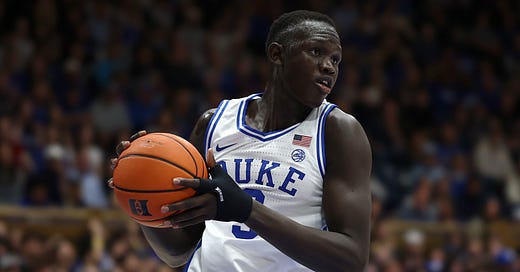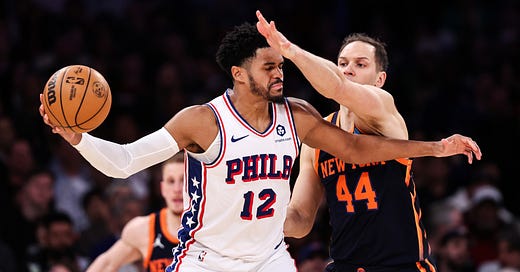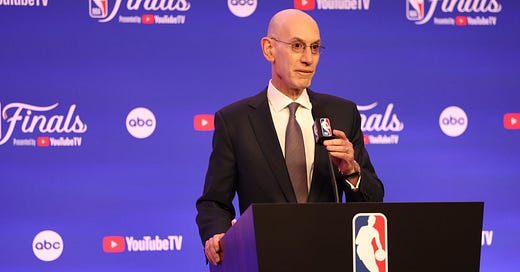
Four Centers the Sixers Could Look at in the 2025 NBA Draft
Here are the 7-footers you need to keep an eye on during March Madness.
It’s been a full decade since the last time the Sixers used a first-round pick on a center.
Ever since drafting Jahlil Okafor third overall in 2015 — the third straight center the Sixers had picked in the lottery up to that point — the team has used its first round-capital to acquire Ben Simmons, Timothe Luwawu-Cabbarot, Furkan Korkmaz, Markelle Fultz, Zhaire Smith, Landry Shamet, Matisse Thybulle, Tyrese Maxey, Jaden Springer and Jared McCain. That’s 10 different players, almost all of whom are guards in some form or another.
It made sense given that the franchise’s future was oriented around a center in their 2014 pick, Joel Embiid. Once he showed what he could be during his rookie season in 2017, centers were all but off-the-table as first-round picks. Why spend an extremely valuable pick on someone who probably can’t be on the floor at the same time as your best player?
But times *could* be changing. Embiid returning from this recent run of injuries and playing at a dominant level should in no way be ruled out of the realm of possibility, but it’s also far from a guarantee. If the Sixers land a top six pick, there’s an argument for just going the best-player-available route and selecting a center if the guards and wings they’d want the most are already off the board.
Of course, the Sixers will already roster a few centers in 2025-26, with Adem Bona already drafted to be the backup center of the future, and Andre Drummond possibly picking up his player option in the summer. Still, with as rough a season as the Sixers have endured, anything and everything should be on the table come draft time. Here are four top-of-the-line centers the team could be eyeing in the coming months:
Khaman Maluach, Duke
Though Flagg is the main reason Duke has stormed to a 28-3 record, Khaman Maluach might be No. 2. The 7-foot-2 center from South Sudan is an imposing force who serves as an incredible defensive anchor, while also adding to the Blue Devils’ offense with his screening, rebounding and vertical spacing as a lob threat.
He averages just 20.6 minutes per game due to a) Duke having an excellent small-ball backup big in Maliq Brown, who does offer more perimeter skill than Maluach, and b) Duke bludgeoning teams so badly that they play all their reserves in the last 10 minutes of each game. Maluach still recorded 34 blocks in 31 games despite the small minute load, and he altered plenty of more shots. His technique both as a drop defender in the pick and roll and switching onto smaller players improved throughout the season, leading to several excellent sequences.
Offensively, Maluach fits the mold of a big who doesn’t seem to mind a lack of shots (at least from an outsider’s perspective). Of the 145 field goals he’s attempted, 117 have come at the rim, per BartTorvik. Almost all of his offense comes via a pick and roll lob from a teammate, or a putback following an offensive rebound, and he is elite in both of those avenues of scoring.
Maluach is understandably limited as a passer and dribbler, as he only started playing basketball in 2019. It speaks to his incredible potential and feel for the game that he very quickly improved at Duke and became a vital piece of an excellent team, owning the paint on both ends of the floor. He’s fifth in the entire country in Offensive Rebound Percentage (17.0%) and top ten in total dunks with 59.
A center who doesn’t try to do too much and excels on defense and the glass is usually the description of a low-ceiling, high-floor player, which might be fair for Maluach. Yet, I believe his ceiling to be much higher. He has every bit of real NBA size at the position. He moves surprisingly well in space for someone that tall. He shows good hands catching the ball in tight spaces. He gets physical fighting for position on the inside, and he won’t turn 19 till September.
Maluach still has room to develop into much more than he is right now, especially with a shooting stroke that isn’t hopeless. He occasionally flashed potential as a shooter prior to his time at Duke, and though he’s just 2-for-13 from three this season, he’s also shot 75% on 64 free throw attempts. The touch is there, even if the results from behind the arc haven’t shown up quite yet. A guy who is 7-foot-2, while still being very mobile, and has shown rapid improvements on both ends of the court at a young age, is hard to put any kind of ceiling on.
Derik Queen, Maryland
There’s little debate that Flagg is the best prospect in this class, but it’s his former high school teammate Derik Queen who might be the most fun to watch.
The Maryland center has a wild combination of strength, short-area quickness, hand-eye coordination, and a willingness to try just about anything on the court. He’ll speed past a defender and finish with finesse like Naz Reid, he’ll take one-legged step-backs modeled after Dirk Nowitzki and Nikola Jokic, and he’ll throw some extremely creative and ambitious passes at a moment’s notice. Every second he’s on the court, there’s a chance that something spectacular happens.
(I included two of his AAU passes in those highlights because those are two of my favorite passes any prospect has ever thrown).
Of course, Queen’s lack of fear on the hardwood does come with some risk. He’s recorded 61 assists in 31 games, but also 75 turnovers – and while he’s made a great deal of mid-range jumpers, he’s shot just 2-for-24 on three-point attempts. Additionally, though this might not matter to most, it’s worth noting that Queen is an older freshman who will be turning 21 during December of his rookie season.
Still, it’s extremely hard to find a big as skilled as Queen. At every level of basketball he’s played — High School, AAU, now College — he’s dominated his competition athletically. He’s too strong to stop inside or keep off the boards, and too quick and fluid with his first step to not be a threat driving from the perimeter.
Asa Newell, Georgia
It’s a little funny that Queen and Asa Newell were high school teammates at Monteverde, seeing as they’re diametrically opposed in play styles. Whereas Queen operates on an open canvas, Newell brings a very buttoned-up approach to the game. He competes hard on both ends of the floor, finishes plays with dunks and threes when asked, and rarely tries to color outside the lines of the team’s design in the halfcourt offense. He operates much more like Maluach than Queen, more often playing within his role instead than daring to venture outside of it.
Of the four centers mentioned in this article, Newell has the most attempts from three this past season, launching 82 triples and connecting on 24 of them (29.3%). Outside of that, it’s pretty much all at-rim for the Georgia big, who connected on 127 of his 176 attempts around the basket (72.2%), per Synergy.
With at least a somewhat-promising shooting stroke mixed in with decent defensive mobility, there’s a possibility that Newell could also moonlight as a 4 in the NBA, though his lack of off-the-dribble work hinders that belief. Newell rarely attempted jumpers that weren’t of the catch-and-shoot variety, and he averaged just under an assist per game. Both are similar limitations ascribed to Maluach, but unlike Maluach, Newell is closer to 6-foot-10 than he is to 7-foot-2, which makes a big difference.
Still, Newell projects as a very high-floor prospect who will likely stick in the NBA regardless of team context with his combination of plus athletic traits and play finishing acumen.
Alex Condon, Florida
While you likely won’t see Condon high on any mainstream mock drafts, he’s simply too talented to not mention in this article. The sophomore big has rocketed up big boards following an incredible season for a 27-4 Florida team that has a very real shot at winning the NCAA title.
The 6-foot-11 Australian big brings a wild combination of athleticism, playmaking feel, and shooting upside that’s hard to find at any level of basketball. According to Synergy, he’s shot 66.4% at the rim (81-for-122) and 34.9% from three (15-for-43), capable of skying for thunderous finishes and spacing the floor to make a hesitant defense pay.
(If you couldn’t tell from those highlights, his performance at Alabama a couple of weeks ago was one of the best games any prospect has played during this past season).
The more intriguing aspect of Condon’s game is his role as a DHO operating hub. Florida trusted him to run their offense on many occasions, and to great success. Condon sees cutters well and isn’t afraid to thread a pass through a tight window, finishing the regular season with 65 assists to just 32 turnovers.
Realistically, unless something big changes in public draft perception over the next few months, Condon won’t be picked in the top six. Even though anchoring bias shouldn’t matter, it’s still hard for someone who originally entered college as a three-star recruit to surpass the five-stars ahead of him in draft rankings, even if Condon has more than proven that original evaluation of him to be wrong. The world where the Sixers end up with him likely involves a trade-back or stealing him with an early second-round selection (in which case, everyone should be ecstatic). But he’s simply been too sensational this season to not mention in the article. A big man with his kind of upside should be on every team’s radar come June.
Daniel Olinger is a writer for the Rights To Ricky Sanchez, and author of “The Danny” column, even though he refuses to be called that in person. He can be followed on X @dan_olinger.
“The Danny” is brought to you by the Official Realtor Of The Process, Adam Ksebe.














